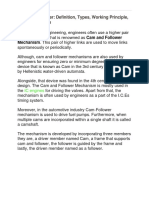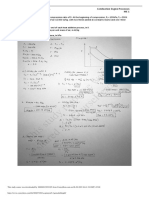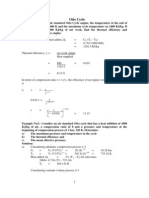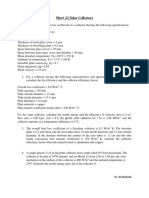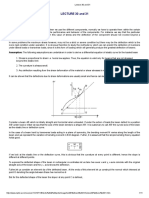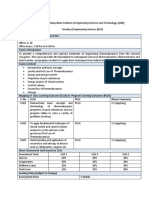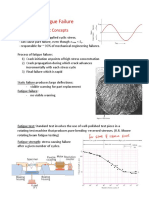100%(2)100% found this document useful (2 votes)
639 viewsStress Concentration Examples
Stress Concentration Examples
Uploaded by
Uday Narasimha1. The document discusses theoretical stress concentration factors (Kt) and provides examples of calculating maximum stress when a stress concentration factor is given for different mechanical components under load.
2. Formulas are given for calculating nominal stress and using the stress concentration factor (Kt) to find maximum stress. Examples include finding maximum stress for a plate with a central hole and a stepped shaft.
3. Additional examples are provided on fatigue theories including calculating factors of safety using different criteria for machine components under fluctuating loads.
Copyright:
© All Rights Reserved
Available Formats
Download as DOCX, PDF, TXT or read online from Scribd
Stress Concentration Examples
Stress Concentration Examples
Uploaded by
Uday Narasimha100%(2)100% found this document useful (2 votes)
639 views5 pages1. The document discusses theoretical stress concentration factors (Kt) and provides examples of calculating maximum stress when a stress concentration factor is given for different mechanical components under load.
2. Formulas are given for calculating nominal stress and using the stress concentration factor (Kt) to find maximum stress. Examples include finding maximum stress for a plate with a central hole and a stepped shaft.
3. Additional examples are provided on fatigue theories including calculating factors of safety using different criteria for machine components under fluctuating loads.
Original Title
stress concentration examples
Copyright
© © All Rights Reserved
Available Formats
DOCX, PDF, TXT or read online from Scribd
Share this document
Did you find this document useful?
Is this content inappropriate?
1. The document discusses theoretical stress concentration factors (Kt) and provides examples of calculating maximum stress when a stress concentration factor is given for different mechanical components under load.
2. Formulas are given for calculating nominal stress and using the stress concentration factor (Kt) to find maximum stress. Examples include finding maximum stress for a plate with a central hole and a stepped shaft.
3. Additional examples are provided on fatigue theories including calculating factors of safety using different criteria for machine components under fluctuating loads.
Copyright:
© All Rights Reserved
Available Formats
Download as DOCX, PDF, TXT or read online from Scribd
Download as docx, pdf, or txt
100%(2)100% found this document useful (2 votes)
639 views5 pagesStress Concentration Examples
Stress Concentration Examples
Uploaded by
Uday Narasimha1. The document discusses theoretical stress concentration factors (Kt) and provides examples of calculating maximum stress when a stress concentration factor is given for different mechanical components under load.
2. Formulas are given for calculating nominal stress and using the stress concentration factor (Kt) to find maximum stress. Examples include finding maximum stress for a plate with a central hole and a stepped shaft.
3. Additional examples are provided on fatigue theories including calculating factors of safety using different criteria for machine components under fluctuating loads.
Copyright:
© All Rights Reserved
Available Formats
Download as DOCX, PDF, TXT or read online from Scribd
Download as docx, pdf, or txt
You are on page 1of 5
Theoretical Stress concentration factor (Kt)
1) Determine the maximum stress produced in a rectangular plate 50mm wide,
8 mm thick with a central hole of 10mm diameter. It is loaded in an axial
tension of 1 KN. Assume stress concentration factor Kt =2.5
Given data
W= 50 mm
h= 8 mm
a= 10 mm
p= 1 KN
Kt =2.5
Kt= maximum stress/nominal stress--------1
Nominal stress = load/area = P/(W-a) *h
= 1000 /(50-10)*8= 1000/320= 3.125 N/mm^2
Substitute nominal stress in equation 1
Nominal stress σ o= 3.125
Maximum stress = Kt* σ o= 2.5*3.125= 7.8125 N/mm^2
1) A stepped shaft has maximum dia = 45mm, minimum dia =
30mm, fillet radius = 6mm, if the shaft is subjected to an axial
load of 10KN. Find the maximum stress induced. Assume Kt =
1.45
σ max= maximum stress in N/mm^2
Kt= σ max /σ o
σ o=10000/¿0.785 d^2 = 10000/ 0.785*900
σ o=¿14.125 Mpa
σ max=¿ 14.125*1.45
= 20.48 Mpa
Note : while calculating nominal stress for a stepped shaft
consider minor diameter (d) in area equation
1. A hollow shaft of 0.5m outside diameter and 0.3m inside
diameter is used to drive a propeller of a marine vessel. The
shaft is mounted on bearings6m apart and it transmits 5600kW
at 150 rpm. The maximum axial propeller shaft is 500kN and
the shaft weighs 70kN. Determine (i).The maximum shear stress
developed in the shaft (ii).The angular twist between the
bearings.
Problems on fatigue theories of failure
1. A machine component is subjected to fluctuating stress that varies from 40
to 100 N/mm2. The corrected endurance limit stress for the machine
component is 270 N/mm2. The ultimate tensile strength and yield strength of
the material are 600 and 450 N/mm2 respectively. Find the factor of safety
using
(i) Gerber theory
(ii) Soderberg line
(iii) Goodman line
Also, find the factor of safety against static failure.
2. An automobile leaf spring is subjected to cyclic stress such that the average
stress is 150Mpa, variable stress is 350Mpa; the material properties are;
ultimate strength = 400Mpa; yield strength = 350Mpa; endurance limit =
270Mpa; estimate the factor of safety using Goodman method and
Soderberg method?
3. A steel rod is subjected to a reversed axial load of 180 kN. Find the diameter
of the rod for a factor of safty of 2. Neglect column action. The material has
an ultimate tensile strength of 1070 Mpa and yield strength of 910 Mpa. The
endurance limit is reversed bending may be assumed to be one half of the
ultimate tensile strength. The correction factors are as follows. Load factor =
0.7; Surface finish factor = 0.8 ;Size factor = 0.85; Stress concentration
factor = 1.
4. A thin wall cylindrical pressure vessel of mean diameter of 60 cm is
subjected to internal pressure varying from 0 to 40 MPa. Find the required
thickness of the pressure vessel based on yield point of 400 MPa, endurance
limit of 22 Mpa, and a factor of safety of 3. Use Soderberg criterion of
failure.
5. A machine component is subjected to a flexural stress which fluctuates
between +300 MN/m2 and –150 MN/m2. Determine the value of minimum
ultimate strength according to: i). Modified Goodman relation; and ii).
Soderberg relation. Take yield strength = 0.55 Ultimate strength; Endurance
strength = 0.5 Ultimate strength; and factor of safety = 2.
6. Find the diameter of a shaft to transmit twisting moment varying from
800N-m to 1200N-m. The ultimate tensile strength for the material is
600MPa and yield stress is 450MPa. Assume the stress concentration
factor=1.2, surface finish factor=0.8 and size factor=0.85.
7. A circular bar of 500mm length is supported freely at its two ends. It is acted
upon by a central concentrated cyclic load having a minimum value of 20kN
and a maximum value of 50kN. Determine the diameter of bar by taking a
factor of safety of 1.5, size effect of 0.85, surface finish of 0.9. The material
properties of bar are given by ultimate strength of 650 MPa, yield strength of
500 MPa and endurance strength of 350 Mpa
8. A steel connecting rod is subjected to a completely reversed axial load of
1,600MPa. Suggest the suitable diameter of the rod using a factor of safety
2. Theultimate tensile strength of the material is 1,100 MPa and yield
strength 930 MPa. Neglect column action and the effect of stress
concentration.
9. A 50 mm diameter shaft is made from carbon steel having ultimate tensile
strength of 630MPa. It is subjected to a torque which fluctuates between
2000 N-m to – 800 Nm. Using Soderberg methods, calculate the factor of
safety. Assume suitable values for any other data needed.
10.A shaft made of steel having ultimate tensile strength of 700 MPa and yield
point 420 MPa is subjected to a torque of 2000 N- m clockwise to 600 N- m
anti-clockwise. Calculate the diameter of the shaft if the factor of safety is 2
and it is based on the yield point and the endurance strength in shear
11.Determine the size of a piston rod subjected to a total load of having cyclic
fluctuations from 150 kN in compression to 25 kN in tension. The endurance
limit is 360 MPa and yield strength is 400 MPa. Take impact factor = 1.25,
factor of safety = 1.5, surface finish factor = 0.88 and stress concentration
factor = 2.25.
12.A simply supported beam has a concentrated load at the center, which
fluctuates from a value of P to 4 P. The span of the beam is 0.5 m and its
cross-section is circular with a diameter of 0.06 m. Taking for the beam
material an ultimate stress of 700 MPa, a yield stress of 500 MPa, endurance
limit of 330 MPa for reversed bending, and a factor of safety of 1.3,
calculate the maximum value of P. Take a size factor of 0.85 and a surface
finish factor of 0.9.
13.A simply supported beam has a point load at the centre which fluctuates
from a value F to 4F. Length of beam is 500 mm and cross section is circular
with a diameter of 60 mm. Ultimate, yield stresses are 700 MPa and 500
MPa respectively. Endurance limit in reverse bending is 330 MPa. Factor of
safety desired is 1.3.Assume size factor 0.83, Surface finish factor 0.9,
reliability factor 1.0.Find the maximum value of F.
You might also like
- Garcia and Avesani Neto 2021 - Stress-Dependent Method For Calculating The Modulus Improvement Factor in Geocell-Reinforced Soil LayersDocument13 pagesGarcia and Avesani Neto 2021 - Stress-Dependent Method For Calculating The Modulus Improvement Factor in Geocell-Reinforced Soil LayersPARCOR S.A.S.0% (1)
- Dme-22 6 15Document8 pagesDme-22 6 15VIGNESH L RNo ratings yet
- ProblemsDocument22 pagesProblemsSuresh GoudNo ratings yet
- Single Stage CompressorDocument5 pagesSingle Stage CompressorHaziq HanifahNo ratings yet
- Cam and Follower: Definition, Types, Working Principle, and ApplicationsDocument17 pagesCam and Follower: Definition, Types, Working Principle, and Applicationsniaz kilamNo ratings yet
- Assignment5 Apurada Mar PDFDocument3 pagesAssignment5 Apurada Mar PDFKing Cyruz PabloNo ratings yet
- Strength of MaterialsDocument66 pagesStrength of MaterialsMohak ShahNo ratings yet
- Assignmsenst For StudentDocument17 pagesAssignmsenst For StudentParth Patel0% (2)
- Destructive TestingDocument8 pagesDestructive TestingAbdul Rehman100% (3)
- Air Standard CycleDocument15 pagesAir Standard CyclePrakhar Deep RanaNo ratings yet
- Set 6Document15 pagesSet 6Tare Er Kshitij60% (5)
- Sheet 2 Flat Plate (4th Mech)Document2 pagesSheet 2 Flat Plate (4th Mech)Mo'men GamalNo ratings yet
- Simple Stress and Strain Relationship: Stress and Strain in Two Dimensions, Principal Stresses, Stress Transformation, Mohr's CircleDocument67 pagesSimple Stress and Strain Relationship: Stress and Strain in Two Dimensions, Principal Stresses, Stress Transformation, Mohr's CircleMushini NagabhushanNo ratings yet
- Solved Problems Stress-Strain DiagramDocument2 pagesSolved Problems Stress-Strain DiagramChristopher Largado100% (2)
- Materials Engr.Document7 pagesMaterials Engr.Ryan TogononNo ratings yet
- Engg Mechanics Ques BankDocument68 pagesEngg Mechanics Ques BankUtkalNo ratings yet
- Torsion of Thin-Walled TubeDocument4 pagesTorsion of Thin-Walled TubeRalph Castillo100% (1)
- Problems Related To Pure BendingDocument15 pagesProblems Related To Pure BendingMuhammad Fazeel Khan0% (1)
- Simple Stresses and StrainsDocument36 pagesSimple Stresses and Strainsfotick100% (1)
- Unit 4Document39 pagesUnit 4rajashekar reddy nallalaNo ratings yet
- 2d Truss Analysis - Mos ProjectDocument8 pages2d Truss Analysis - Mos ProjectMarsha WongNo ratings yet
- CA04 ParchamentoJVMDocument6 pagesCA04 ParchamentoJVMJohnrey ParchamentoNo ratings yet
- Mechanics of Deformable Bodies: Mapúa Institute of TechnologyDocument16 pagesMechanics of Deformable Bodies: Mapúa Institute of TechnologyAhsan AliNo ratings yet
- Torsion - Notes PDFDocument20 pagesTorsion - Notes PDFRichy Rahul AdithyaNo ratings yet
- Unit 5Document84 pagesUnit 5Prasanna Sekar100% (1)
- ME Elective 1 Engine Friction LubricationDocument7 pagesME Elective 1 Engine Friction LubricationrickyNo ratings yet
- Torsional StressDocument19 pagesTorsional StressWilsonLiriosNo ratings yet
- Thermal Stress: Mechanics of Deformable BodiesDocument10 pagesThermal Stress: Mechanics of Deformable BodiesPao CastillonNo ratings yet
- Solution Examples 1.3 - Mechanical Properties of MaterialsDocument26 pagesSolution Examples 1.3 - Mechanical Properties of MaterialsRicardo Wan Aguero100% (2)
- Stresses and Strains PDFDocument44 pagesStresses and Strains PDFAnvi JainNo ratings yet
- ETD Chapter 2Document18 pagesETD Chapter 2Vasantha SeelanNo ratings yet
- Chapter 1Document12 pagesChapter 1Lester Neil LomodNo ratings yet
- Chapter (3) Simple Stresses in Machine Parts: Design of Machine Elements I (ME-41031)Document80 pagesChapter (3) Simple Stresses in Machine Parts: Design of Machine Elements I (ME-41031)Dr. Aung Ko Latt100% (1)
- 15me03 Basic ThermodynamicsDocument20 pages15me03 Basic ThermodynamicsVaratha Rajan0% (1)
- 02 03ChapGereDocument16 pages02 03ChapGereXavier Pacheco PaulinoNo ratings yet
- Problems in TransformerDocument8 pagesProblems in TransformerNANDHAKUMAR A100% (1)
- Mechanics of Materials (CH 3 and 4Document19 pagesMechanics of Materials (CH 3 and 4Praveen Kumar RNo ratings yet
- Multi Degree of Freedom Systems - 1Document46 pagesMulti Degree of Freedom Systems - 1soqhNo ratings yet
- Strength of Materials/ Unit 7/ Module 2 Torsion II: Problem SetDocument22 pagesStrength of Materials/ Unit 7/ Module 2 Torsion II: Problem Setneeru143No ratings yet
- Exercises Problem No. 2 Keys and Coupling-1Document2 pagesExercises Problem No. 2 Keys and Coupling-1Ariel GamboaNo ratings yet
- Design of Screw FastenersDocument6 pagesDesign of Screw FastenersJosa FatyNo ratings yet
- Solution Manual Mechanics J L MariamDocument74 pagesSolution Manual Mechanics J L MariamPepeE.Benítez100% (1)
- Som Part B CDocument16 pagesSom Part B CSrini VasanNo ratings yet
- Three Process CycleDocument5 pagesThree Process CycleAnalie Buerano SagunNo ratings yet
- Machine Design Question PaperDocument2 pagesMachine Design Question Papersushil.vgi100% (1)
- Final Requirement IN EE320A/L: (Basic Electrical Engineering)Document25 pagesFinal Requirement IN EE320A/L: (Basic Electrical Engineering)Andre RoqueteNo ratings yet
- Design of Machine Elements2Document14 pagesDesign of Machine Elements2Satwik PriyadarshiNo ratings yet
- Tutorial For Topic 2 - SolutionDocument4 pagesTutorial For Topic 2 - Solutionmurwanashyaka augustin100% (1)
- Assignment QuestionDocument15 pagesAssignment QuestionPratik WalimbeNo ratings yet
- Tutorial 1 - Suggested AnswerDocument2 pagesTutorial 1 - Suggested AnswerBárbara VictóriaNo ratings yet
- Variable Stresses With Stress ConcentrationsDocument16 pagesVariable Stresses With Stress ConcentrationsBryan GounzoNo ratings yet
- Remedial 2Document5 pagesRemedial 2RYAN A RAMIREZNo ratings yet
- Auto TransformerDocument5 pagesAuto TransformerAugy HaerudyNo ratings yet
- SM - Chapter 9 Combined StressDocument31 pagesSM - Chapter 9 Combined StressAnik hasan Badhon100% (1)
- KeysDocument26 pagesKeysMontu Chintu100% (1)
- O Q (Gate, Ies, Ias) : Bjective Uestions Previous 20-Years GATE Questions Helical SpringDocument16 pagesO Q (Gate, Ies, Ias) : Bjective Uestions Previous 20-Years GATE Questions Helical SpringharshdeepNo ratings yet
- Bending StressDocument16 pagesBending Stresspalash1401No ratings yet
- m1 Stress, StrainDocument90 pagesm1 Stress, StrainAldwin AjocNo ratings yet
- Lab 3 - Hydrostatic Forces On Plane and Curved SurfacesDocument5 pagesLab 3 - Hydrostatic Forces On Plane and Curved SurfacesAlyssa Suzanne TafallaNo ratings yet
- 2 PDFDocument1 page2 PDFAtulkumarSutharNo ratings yet
- DMM_UNIT-1 QuestionsDocument3 pagesDMM_UNIT-1 Questionsprokranthi5No ratings yet
- Unit IiDocument1 pageUnit Iimahesh babu bandiNo ratings yet
- Design of Machine Members-I April 2019Document8 pagesDesign of Machine Members-I April 2019Uday NarasimhaNo ratings yet
- UNIT-5 SpringsDocument6 pagesUNIT-5 SpringsUday Narasimha100% (2)
- A Weight of 1400 N Is Dropped On To A Collar at The Lower End of A Vertical Steel Shaft of 3m Long and 25 MMDocument1 pageA Weight of 1400 N Is Dropped On To A Collar at The Lower End of A Vertical Steel Shaft of 3m Long and 25 MMUday NarasimhaNo ratings yet
- DESIGN OF MACHINE MEMBERS-I r16 Nov 2019Document2 pagesDESIGN OF MACHINE MEMBERS-I r16 Nov 2019Uday NarasimhaNo ratings yet
- Design of Machine Members-IDocument8 pagesDesign of Machine Members-IUday NarasimhaNo ratings yet
- Use of Strain Gauge Rosette To Investigate Stress Concentration in Isotropic and Orthotropic Plate With Circular HoleDocument5 pagesUse of Strain Gauge Rosette To Investigate Stress Concentration in Isotropic and Orthotropic Plate With Circular HoleHako KhechaiNo ratings yet
- NPTEL Course: Ground ImprovementDocument68 pagesNPTEL Course: Ground ImprovementroshanrsvNo ratings yet
- Section 18 AASHTODocument5 pagesSection 18 AASHTOoscarpetroflexNo ratings yet
- Flexural Properties of Thin-Section Glass-Fiber-Reinforced Concrete (Using Simple Beam With Third-Point Loading)Document3 pagesFlexural Properties of Thin-Section Glass-Fiber-Reinforced Concrete (Using Simple Beam With Third-Point Loading)Ghazi Al ObaidiNo ratings yet
- Deflection NptelDocument11 pagesDeflection NptelhariNo ratings yet
- Nanoscience and Technology 2017Document3 pagesNanoscience and Technology 2017SnehardraNo ratings yet
- Weldability of Forged AISI 4130 and 1020 MN SteelsDocument5 pagesWeldability of Forged AISI 4130 and 1020 MN SteelsJHNo ratings yet
- ABS Fatigue Life Assessment 2014Document1 pageABS Fatigue Life Assessment 2014Fandy SipataNo ratings yet
- Stress. When Forces Cause A Compression of An Object, We Call It A Compressive Stress. When An Object Is Being Squeezed From All Sides, Like A Submarine in The DepthsDocument1 pageStress. When Forces Cause A Compression of An Object, We Call It A Compressive Stress. When An Object Is Being Squeezed From All Sides, Like A Submarine in The DepthsDI VAVNo ratings yet
- Reciprocal LatticeDocument38 pagesReciprocal LatticeBinoy NambiarNo ratings yet
- EN24TDocument3 pagesEN24ThorzsNo ratings yet
- Universiti Teknologi Mara Final Examination: Confidential EC/OCT 2009/ECS308/KJC324Document5 pagesUniversiti Teknologi Mara Final Examination: Confidential EC/OCT 2009/ECS308/KJC324Faiz NajidNo ratings yet
- One-Way Tamm Plasmon-Polaritons On The Interface of Magnetophotonic Crystals and Conducting Metal OxidesDocument5 pagesOne-Way Tamm Plasmon-Polaritons On The Interface of Magnetophotonic Crystals and Conducting Metal OxidesedirozemberghNo ratings yet
- Ghulam Ishaq Khan Institute of Engineering Sciences and Technology, (GIKI) Faculty of Engineering Sciences (FES)Document3 pagesGhulam Ishaq Khan Institute of Engineering Sciences and Technology, (GIKI) Faculty of Engineering Sciences (FES)bilal khanNo ratings yet
- Chapter 6: Fatigue Failure: Introduction, Basic ConceptsDocument21 pagesChapter 6: Fatigue Failure: Introduction, Basic ConceptsNick MezaNo ratings yet
- MSE241: Polymer Science: Dr. Nasir AhmadDocument26 pagesMSE241: Polymer Science: Dr. Nasir AhmadAsim KhanNo ratings yet
- Types of RebarDocument3 pagesTypes of RebarSanderNo ratings yet
- 10.1007@978 981 15 3669 4Document388 pages10.1007@978 981 15 3669 4Muhammad Abdur RashidNo ratings yet
- Direct Method Obtaining Plate Buckling Coefficient Double-Coped BeamDocument2 pagesDirect Method Obtaining Plate Buckling Coefficient Double-Coped Beamclam2014No ratings yet
- Exercises V1 Part2Document8 pagesExercises V1 Part2Ahmed AlgadriNo ratings yet
- Transmission Electron MicrosDocument27 pagesTransmission Electron Microsipog_2k1No ratings yet
- Viscosity Grading of Bitumen and Consistency Properties: AbsoluteDocument12 pagesViscosity Grading of Bitumen and Consistency Properties: AbsoluteManglemnganba LaishramNo ratings yet
- Whitford Fusion HR-TEST (Milk Non-Stick - Salt)Document2 pagesWhitford Fusion HR-TEST (Milk Non-Stick - Salt)minhee kimNo ratings yet
- Aula 7 - Vigas - Parte 1Document19 pagesAula 7 - Vigas - Parte 1Marcelo Zapata MuñozNo ratings yet
- Von Mises Yield CriterionDocument4 pagesVon Mises Yield CriterionRisantoNo ratings yet
- Mechanical Properties of SolidsDocument4 pagesMechanical Properties of SolidsSteveMathewKuruvillaNo ratings yet
- Cold Weld Cracking Susceptibility of High Strength Low Alloyed (Hsla) Steel Nionikral 70 - MET - 53 - 4 - 624 - 626 - Tawengi PDFDocument3 pagesCold Weld Cracking Susceptibility of High Strength Low Alloyed (Hsla) Steel Nionikral 70 - MET - 53 - 4 - 624 - 626 - Tawengi PDFarjun prajapatiNo ratings yet
- Mechanical Properties Material Properties Optical PropertiesDocument1 pageMechanical Properties Material Properties Optical PropertiesHardy SPNo ratings yet




